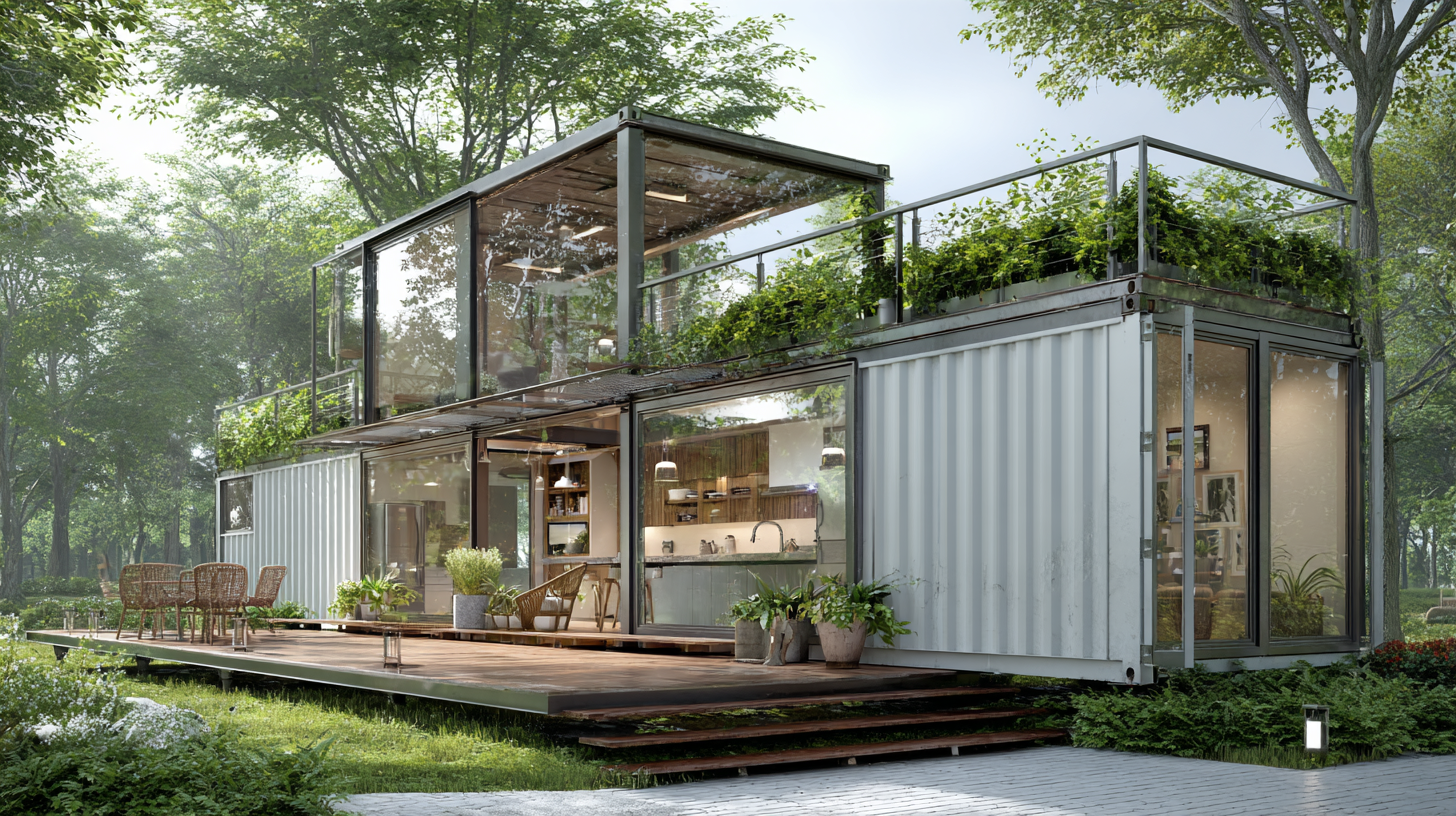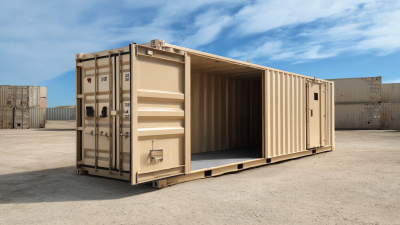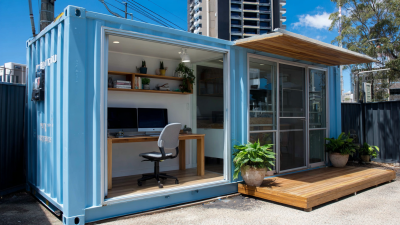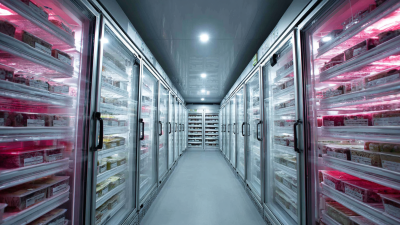Unlocking Sustainability: Innovative Uses of Cargo Containers in Green Architecture
In the pursuit of a more sustainable future, innovative architectural solutions are at the forefront of addressing environmental challenges. One of the most promising trends is the use of cargo containers in green architecture. According to a recent report by the Global Sustainability Initiative, the conversion of cargo containers into homes and commercial spaces could reduce construction waste by up to 75%, significantly lowering the environmental impact of new builds. This novel approach not only champions eco-friendly practices but also offers a cost-effective alternative in the housing market, addressing urbanization and housing shortages simultaneously.

Experts in the field, such as Dr. Jane Holloway, a leading figure in sustainable architecture, emphasize the potential of cargo containers for transformative design solutions. She states, "Cargo containers are more than just shipping tools; they are the building blocks of a sustainable future, capable of reshaping our urban landscapes." By incorporating these robust structures into architectural practices, designers are rethinking space utilization and minimizing the carbon footprint associated with traditional construction methods. With increasing advocacy for sustainable living, the innovative applications of cargo containers represent a pivotal shift towards a greener world in both residential and commercial contexts.
Exploring the Rise of Cargo Container Homes: A Sustainable Housing Solution
As the need for sustainable and affordable housing solutions grows, cargo container homes have emerged as a viable alternative. With the global container homes market projected to reach USD 95.74 billion by 2033, it is clear that this innovative housing model is capturing the interest of many. These homes not only utilize eco-friendly design principles but also provide flexibility and cost-effectiveness, making them an attractive option for modern living. The Rising Sun, a recent design by UnContained Dreams, highlights the movement towards high-quality constructions using high-cube shipping containers, which optimize space and efficiency.
The shift towards non-traditional housing options, particularly cargo container homes, is increasingly evident among local homebuyers. Reports indicate that many are seeking solutions that address affordability without compromising on style or sustainability. For instance, as urban areas face housing crises, initiatives in places like Ghana are transforming shipping containers into eco-friendly homes, while cities like Atlanta are leveraging this trend to combat homelessness. These advancements underscore the potential of cargo container homes to serve as critical components in the future of urban and sustainable living.
The Economic Benefits of Utilizing Cargo Containers in Green Building Projects
The economic benefits of utilizing cargo containers in green building projects are manifold. Firstly, the cost-effectiveness of sourcing and repurposing used cargo containers significantly reduces construction expenses. Compared to traditional building materials, these containers are often available at a fraction of the price, allowing developers to allocate budget toward other sustainable features, such as solar panels or green roofs. Additionally, the reduced necessity for extensive foundations and the expedited construction process contribute to lower labor costs and quicker project turnover.
Moreover, the use of cargo containers promotes sustainability not only through resourcefulness but also through energy efficiency. As these containers are often designed to endure harsh conditions, they inherently offer great insulation properties. By converting them into living or working spaces, builders can minimize energy consumption needed for heating and cooling, leading to long-term savings on energy bills. The ability to stack and arrange these containers in innovative ways also maximizes space utilization, making them ideal for compact urban developments while minimizing environmental footprints.
Unlocking Sustainability: Economic Benefits of Utilizing Cargo Containers in Green Building Projects
Innovative Insulation Techniques for Enhanced Energy Efficiency in Container Architecture
Innovative insulation techniques play a vital role in enhancing energy efficiency within container architecture. As cargo containers are repurposed for homes, offices, and community spaces, the challenge of temperature regulation becomes paramount. One promising approach involves the use of advanced insulating materials, such as aerogel and spray foam, which provide superior thermal resistance while minimizing weight. These materials can be seamlessly integrated into the container's structure, significantly reducing energy consumption for heating and cooling.
Additionally, the incorporation of green insulation methods, like natural fiber composites, presents a sustainable alternative. Materials such as sheep’s wool, hemp, or recycled denim not only offer effective thermal performance but also contribute to indoor air quality and overall environmental sustainability. By adopting these innovative insulation techniques, container architecture can achieve remarkable energy efficiency, ultimately reducing the building's carbon footprint and promoting a greener future in urban development.

Case Studies: Successful Cargo Container Deployments in Eco-Friendly Urban Developments
 The innovative use of cargo containers in eco-friendly urban developments exemplifies a shift towards sustainable architecture. One notable case study is the St. Petersburg Container Park in Florida, where repurposed shipping containers form a vibrant retail space. This development not only reduces waste by giving new life to discarded containers but also supports local businesses in a mixed-use environment. The project integrates green roofs and energy-efficient designs, showcasing how cargo containers can facilitate sustainable urban living without compromising aesthetics or functionality.
The innovative use of cargo containers in eco-friendly urban developments exemplifies a shift towards sustainable architecture. One notable case study is the St. Petersburg Container Park in Florida, where repurposed shipping containers form a vibrant retail space. This development not only reduces waste by giving new life to discarded containers but also supports local businesses in a mixed-use environment. The project integrates green roofs and energy-efficient designs, showcasing how cargo containers can facilitate sustainable urban living without compromising aesthetics or functionality.
 Another remarkable example is the Big Idea project in Cape Town, South Africa. Here, containers were transformed into affordable housing units, addressing the critical need for low-cost accommodation in urban areas. The design incorporates solar panels and rainwater harvesting systems, promoting energy efficiency and water conservation. This approach highlights the potential of cargo containers to provide not only shelter but also sustainable living solutions that meet community needs while fostering environmental responsibility. Through these initiatives, cargo containers prove to be a versatile resource in achieving green architecture and urban sustainability.
Another remarkable example is the Big Idea project in Cape Town, South Africa. Here, containers were transformed into affordable housing units, addressing the critical need for low-cost accommodation in urban areas. The design incorporates solar panels and rainwater harvesting systems, promoting energy efficiency and water conservation. This approach highlights the potential of cargo containers to provide not only shelter but also sustainable living solutions that meet community needs while fostering environmental responsibility. Through these initiatives, cargo containers prove to be a versatile resource in achieving green architecture and urban sustainability.
The Future of Construction: Projected Growth of Cargo Container Use in Sustainable Architecture
The projected growth of cargo container use in sustainable architecture reflects a significant shift towards innovative building practices that prioritize environmental responsibility. As the mobile container housing market is anticipated to expand from a valuation of $1.6 billion in 2025 to $3.06 billion by 2034, with a robust compound annual growth rate (CAGR) of 7.5%, this trend indicates a rising interest in repurposed structures. The adaptability of cargo containers provides an efficient solution for creating affordable housing and eco-friendly designs, aligning closely with the principles of sustainable architecture.

Furthermore, the intermediate container market is expected to witness growth from $10.47 billion in 2025 to $15.62 billion by 2032, reflecting an annual growth rate of 5.88%. This increase not only signifies the growing acceptance of reusable materials but also highlights the potential of cargo containers in various applications beyond traditional shipping purposes. As architects and builders harness these trends, the future of construction will increasingly integrate cargo containers as a fundamental component of sustainable development, reinforcing the commitment to a more sustainable built environment.
Related Posts
-

Innovative Shipping Container Conversions Driving Sustainable Living Trends in Urban Areas
-

Maximize Your Space with 20ft Storage Containers for Efficient Organization and Cost Savings
-

Revolutionizing Food Storage with Shipping Container Freezers for Sustainable Business Solutions
-

Revolutionizing Shipping: The Future of Refrigerated Containers in Cold Chain Logistics
-

Transforming Your Home Office with a 20ft Shipping Container Solution
-

Maximizing Freshness: Innovative Uses for Refrigerated Containers in the Food Industry
Get a quote
Get a quote
Read More
Accept AllReject AllCustomise
Privacy Overview
| Cookie | Duration | Description |
|---|---|---|
| cookielawinfo-checkbox-advertisement | 1 year | Set by the GDPR Cookie Consent plugin, this cookie records the user consent for the cookies in the "Advertisement" category. |
| cookielawinfo-checkbox-analytics | 11 months | This cookie is set by GDPR Cookie Consent plugin. The cookie is used to store the user consent for the cookies in the category "Analytics". |
| cookielawinfo-checkbox-functional | 11 months | The cookie is set by GDPR cookie consent to record the user consent for the cookies in the category "Functional". |
| cookielawinfo-checkbox-necessary | 11 months | This cookie is set by GDPR Cookie Consent plugin. The cookies is used to store the user consent for the cookies in the category "Necessary". |
| cookielawinfo-checkbox-others | 11 months | This cookie is set by GDPR Cookie Consent plugin. The cookie is used to store the user consent for the cookies in the category "Other. |
| cookielawinfo-checkbox-performance | 11 months | This cookie is set by GDPR Cookie Consent plugin. The cookie is used to store the user consent for the cookies in the category "Performance". |
| CookieLawInfoConsent | 1 year | CookieYes sets this cookie to record the default button state of the corresponding category and the status of CCPA. It works only in coordination with the primary cookie. |
| viewed_cookie_policy | 11 months | The cookie is set by the GDPR Cookie Consent plugin and is used to store whether or not user has consented to the use of cookies. It does not store any personal data. |
| Cookie | Duration | Description |
|---|---|---|
| _cs_c | 1 year 1 month | The cookie is used by Content Square to save the user consent to be tracked. |
| Cookie | Duration | Description |
|---|---|---|
| _cs_id | 1 year 17 days 20 hours 13 minutes | This cookie is used to store the ContentSquare's user identifier ID. This is a persistent cookie and expires after 13 months. |
| _cs_s | 1 hour | This cookie is used to store the number of page's viewed by a visitor within the session for ContentSquare's solution. |
| _ga | 1 year 1 month 4 days | Google Analytics sets this cookie to calculate visitor, session and campaign data and track site usage for the site's analytics report. The cookie stores information anonymously and assigns a randomly generated number to recognise unique visitors. |
| _ga_* | 1 year 1 month 4 days | Google Analytics sets this cookie to store and count page views. |
| _gcl_au | 3 months | Google Tag Manager sets the cookie to experiment advertisement efficiency of websites using their services. |
| Cookie | Duration | Description |
|---|---|---|
| test_cookie | 15 minutes | doubleclick.net sets this cookie to determine if the user's browser supports cookies. |
| Cookie | Duration | Description |
|---|---|---|
| _cs_root-domain | session | Description is currently not available. |
| _cs_same_site | session | Description is currently not available. |